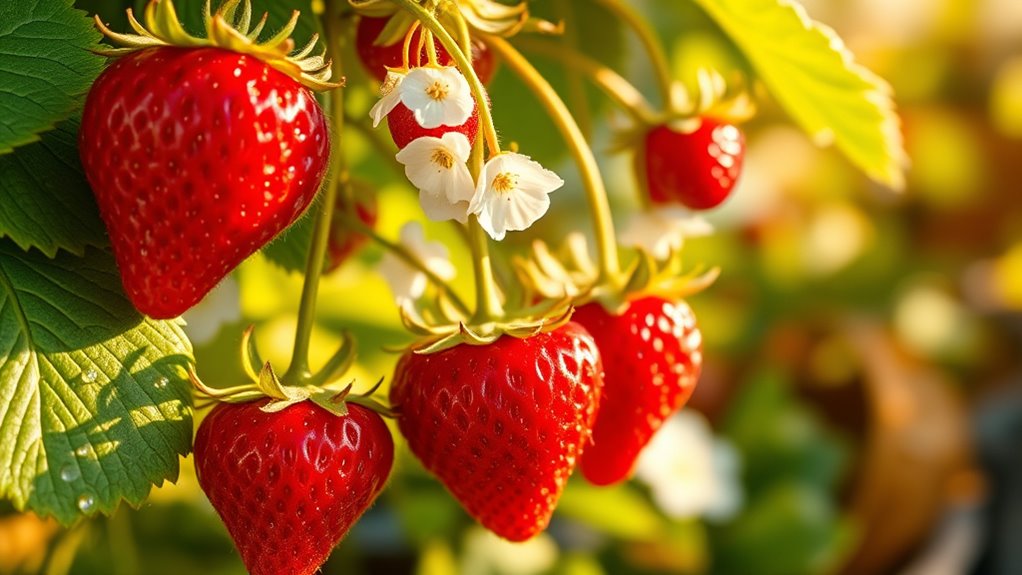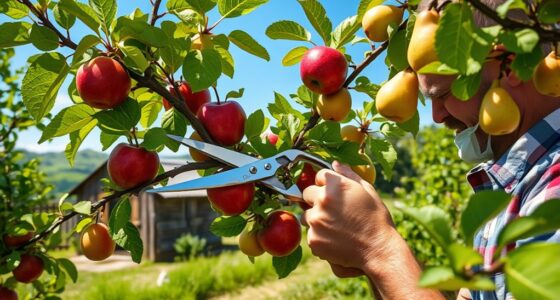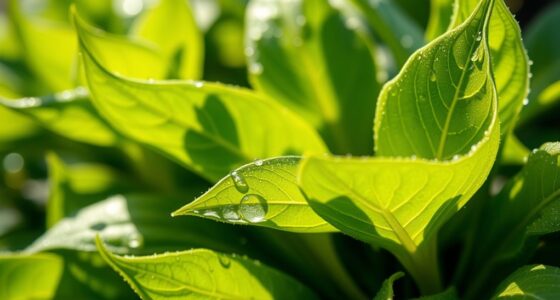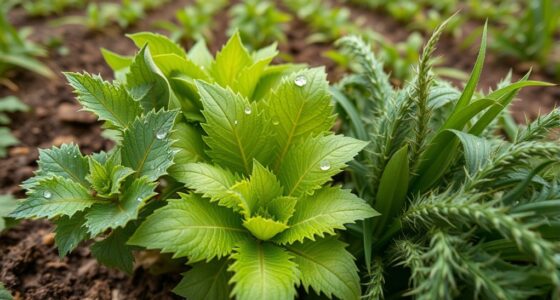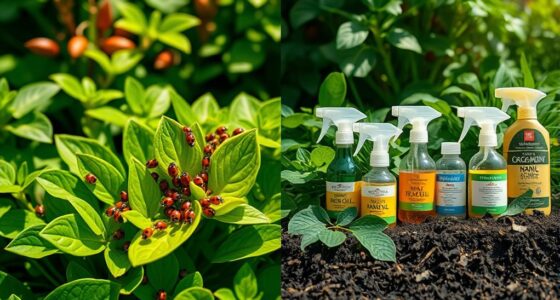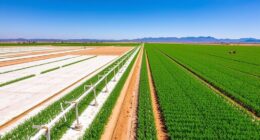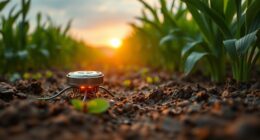To grow strawberries successfully, you need to plant them in spring or fall, spacing each plant 18 inches apart in enriched, slightly acidic soil. Make certain they get at least 8 hours of sunlight and water them weekly, keeping leaves dry. Don't forget to pinch off flower buds in the first year to promote growth. Look out for pest issues and guarantee proper care to boost your yield. There's plenty more to discover to guarantee your strawberry garden thrives!
Key Takeaways
- Plant strawberries in spring or fall in well-draining, slightly acidic soil, spaced 18 inches apart for optimal growth.
- Ensure full sun exposure with at least 8 hours of direct sunlight daily to promote healthy fruit production.
- Water strawberries consistently, providing 1 to 1.5 inches of moisture weekly, while keeping leaves dry to prevent disease.
- Harvest fully ripe berries every three days for peak flavor, and store them unwashed in the refrigerator for 3 to 5 days.
- Use organic mulch to retain soil moisture, regulate temperature, and enhance soil fertility for robust plant growth.
Quick Guide to Growing Strawberries
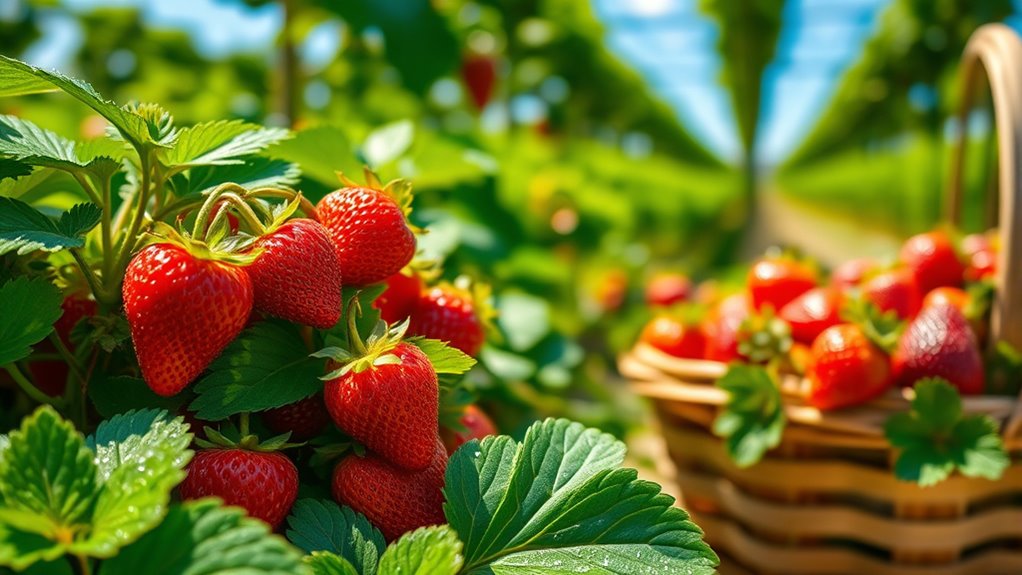
If you want to grow delicious strawberries, start by planting them in spring or fall, spacing each plant 18 inches apart.
Confirm your soil is enriched with organic matter, aiming for a slightly acidic pH between 5.5 and 6.8. Your plants need full sun, so choose a spot that gets at least 8 hours of direct sunlight daily.
Water them thoroughly, providing 1 to 1.5 inches of moisture weekly, but avoid wetting the leaves to prevent disease.
In the first year, pinch off flower buds to focus on root and leaf development.
Once they're ready, harvest strawberries when they're fully red. Check daily for ripeness, and store them in the refrigerator immediately after picking to extend their shelf life.
The Strawberry Life Cycle

Understanding the strawberry life cycle is essential for successful cultivation, as these hardy perennials exhibit remarkable resilience.
Strawberry plants thrive in various climates, producing fruit from February in warmer regions to June in cooler ones. During the growing season, they develop runners that can propagate nearby but remain attached to the parent plant. Clipping these runners helps focus energy on fruit production, boosting yield from the main plant.
In fall, strawberry plants prepare for the next cycle by developing latent buds that will bloom in spring. The average time from flowering to ripe berries is about 30 days, with varieties classified as June-bearing, ever-bearing, or day-neutral, each offering unique fruiting schedules to maximize your harvest.
Soil, Planting, and Care
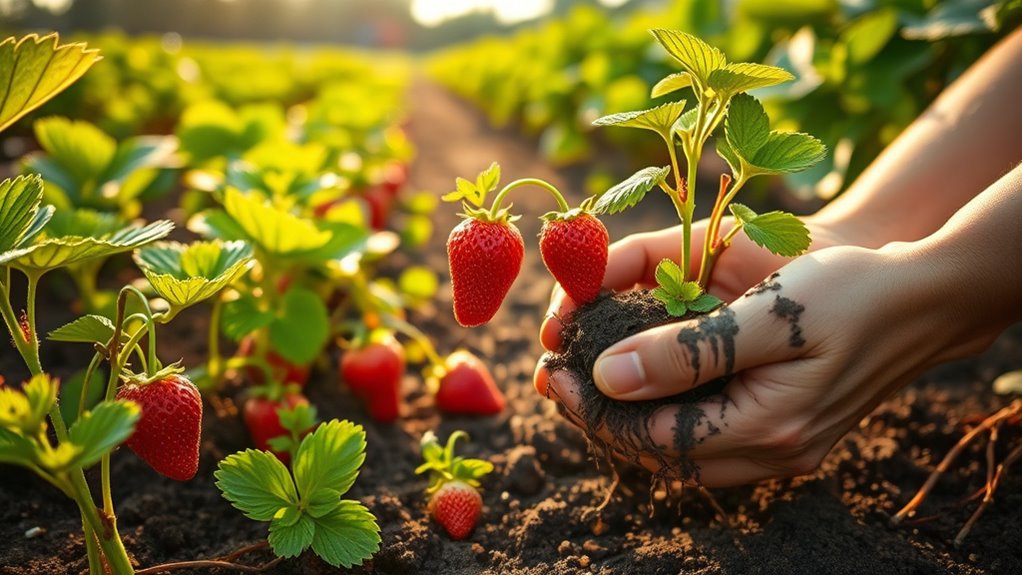
To achieve a thriving strawberry patch, you need to start with the right soil and planting techniques. Strawberries thrive in slightly acidic soil, ideally with a pH between 5.5 and 6.8. Enhance your native soil with aged compost for better growth.
When planting, space your strawberries 18 inches apart and make certain they get at least 8 hours of sunlight daily. For watering, aim for 1 to 1.5 inches weekly while avoiding wet leaves to reduce disease risk.
Mulch with straw or organic matter to retain moisture and protect against temperature changes. Finally, during the spring of the planting year, pinch off flower buds to help your plants focus energy on developing strong roots and leaves, ensuring healthier strawberries.
Types of Strawberries
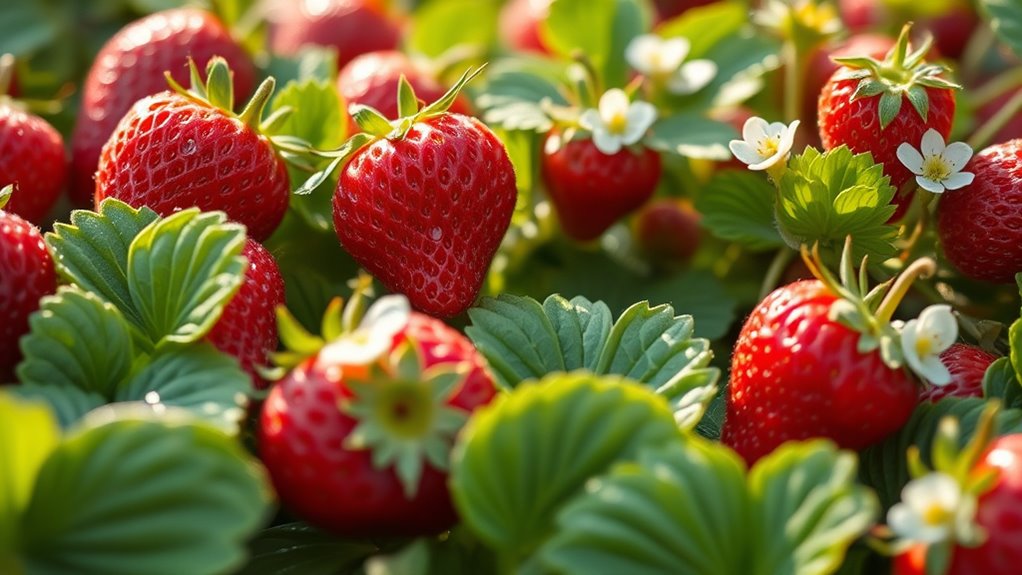
When it comes to strawberries, you've got a few main types to choose from.
June-bearing varieties give you a big harvest in a short period, while ever-bearing and day-neutral types offer more flexibility throughout the season.
Understanding these options will help you select the best fit for your garden.
June-Bearing Varieties
If you're looking to enjoy a bountiful harvest of strawberries in a short time, June-bearing varieties might be your best bet.
These strawberries produce the largest fruit and yield a concentrated harvest over just 2-3 weeks, typically from mid-June to early July.
To guarantee ideal growth, consider these tips:
- Choose popular varieties like Earliglow, Jewel, and Honeoye for exceptional flavor.
- Plant in full sun, ensuring they receive 8+ hours of light daily.
- Maintain slightly acidic soil with a pH of 5.5 to 6.8.
- Manage runners to prevent overcrowding and boost fruit yield.
Everbearing and Day-Neutral
Everbearing and day-neutral strawberries offer a delightful alternative to the traditional June-bearing varieties, allowing you to enjoy fresh fruit throughout the growing season.
Everbearing strawberries typically produce two main harvests, in early summer and again in early fall, yielding moderate-sized berries with a sweet flavor. They tend to have fewer runners, making them easier to manage in smaller spaces. Popular everbearing varieties like Seascape and Albion are known for their consistent fruit production.
On the other hand, day-neutral strawberries, such as Tribute and Fern, aren't affected by day length and can produce fruit continuously as long as temperatures stay between 35°F and 85°F, giving you a longer harvest window compared to June-bearing types.
Harvest and Storage
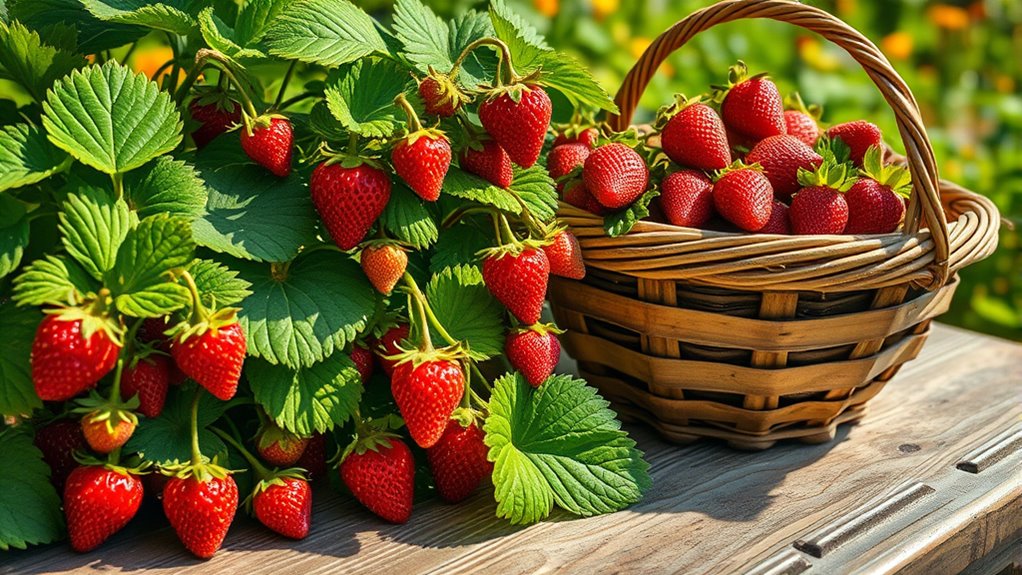
To guarantee you enjoy the best flavor and sweetness from your strawberries, harvest them when they're fully red, which typically occurs 4 to 6 weeks after blooming.
Pick berries every three days during the season to assure peak ripeness and prevent overripening. Handle strawberries carefully by cutting them at the stem to avoid damaging the plant.
Here's how to store and preserve your strawberries:
- Store unwashed strawberries in the refrigerator to extend shelf life for 3 to 5 days.
- Freeze strawberries for up to 2 months for later use.
- Dehydrate strawberries for a tasty snack.
- Make jams or preserves to savor their flavor year-round.
Enjoy every delicious bite!
Managing Pests and Diseases
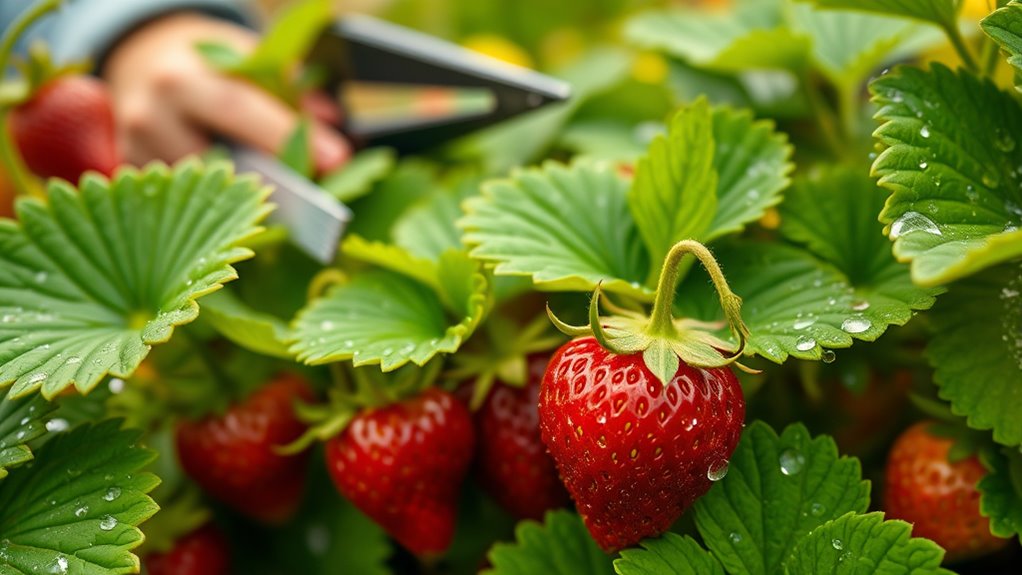
After enjoying the delicious flavors of your freshly harvested strawberries, it's important to protect your plants from pests and diseases that can threaten their health and productivity.
Monitor plants regularly to catch issues early, especially pests of strawberries like the tarnished plant bug, slugs, and spider mites. You can control insects by removing them manually or using diatomaceous earth.
Implement preventative measures such as ensuring good air circulation and maintaining a weed-free environment to reduce the risk of diseases and pests. To protect strawberries from birds, use netting or physical barriers.
Don't forget to renovate strawberry beds annually by mowing or cutting foliage before August 1, which promotes healthier plants and improved fruit production for the next season.
Troubleshooting Common Issues
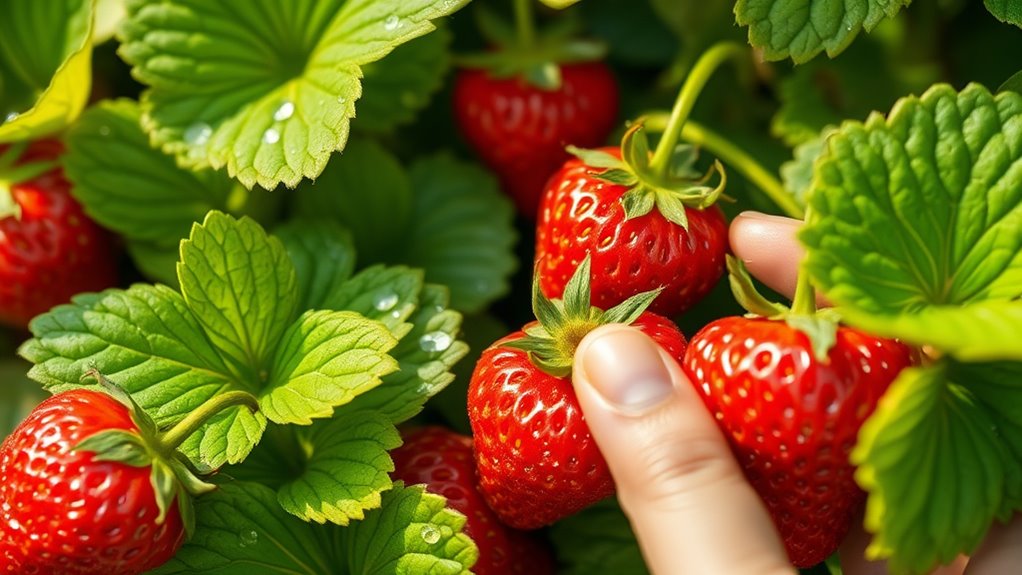
If you notice poor fruit production in your strawberry plants, it's time to troubleshoot some common issues.
Look out for pests, diseases, and soil problems that could be impacting your yields.
Poor Fruit Production
Poor fruit production in strawberries can be frustrating, but identifying the root causes can help you turn things around. Here are some common issues to check:
- Sunlight: Make sure your plants get at least 6-10 hours of direct sunlight daily for ideal growth.
- Overcrowding: Space your plants 12 to 18 inches apart to improve air circulation and nutrient access.
- Soil Conditions: Aim for slightly acidic soil (pH 5.5 to 6.8) and improve drainage by adding compost to heavy clay soils.
- Pollination: Enhance fruit set by encouraging bees with nearby pollinator-friendly flowers, ensuring they can access the blooms.
Pest and Disease Control
To keep your strawberry plants healthy and productive, staying vigilant against pests and diseases is essential. Monitor regularly for signs of problems, as early detection can greatly reduce crop loss.
Guarantee proper air circulation and avoid overhead watering to keep leaves dry, which helps prevent diseases like gray mold and powdery mildew. Implement pest control measures like creating a protective barrier using organic mulching, which also aids in moisture retention.
For common pests such as tarnished plant bugs and slugs, consider manual removal or diatomaceous earth. Additionally, plant strawberries in well-drained soil and avoid planting near previous crops like tomatoes to prevent soil-borne diseases.
Staying proactive will help you enjoy bountiful strawberry harvests.
Soil and Nutrient Issues
Understanding soil and nutrient issues is essential for growing healthy strawberries, as the right conditions can greatly impact your plants' productivity. Here are some key considerations:
- Test your soil pH; strawberries thrive in a slightly acidic range of 5.5 to 6.8.
- Improve drainage by amending heavy clay soils with compost to prevent waterlogged roots.
- Incorporate well-rotted compost or organic matter to boost soil fertility and promote growth.
- Apply a high-potassium fertilizer, like Miracle-Gro® Performance Organics®, to support fruit development.
Don't forget to mulch with straw; it retains moisture and adds organic matter as it decomposes, enhancing overall soil health.
Frequently Asked Questions
What Is the Trick to Growing Strawberries?
The trick to growing strawberries lies in providing the right conditions.
Make sure your plants get at least 8 hours of sun daily and space them 12 to 18 inches apart for good airflow.
Use slightly acidic soil and water them regularly, about 1 to 1.5 inches each week, without wetting the leaves.
Don't forget to pinch off flower buds early on to encourage stronger growth before the fruit starts to develop.
What Should You Not Plant Near Strawberries?
When you're planting strawberries, think of them as delicate treasures in a garden.
You wouldn't want to surround them with competitors or foes. Avoid planting them near nightshades like tomatoes, brassicas like cabbage, or aggressive herbs like mint.
Also, steer clear of other berries that attract pests.
Finally, don't place them near heavy nitrogen plants, as they might steal the spotlight and leave your strawberries lacking in fruit production.
What Do Coffee Grounds Do for Strawberry Plants?
Coffee grounds boost strawberry plants by enhancing soil acidity, which they thrive in. They provide essential nitrogen, promoting healthy growth and fruit production.
When you incorporate coffee grounds into your soil, you improve its structure and drainage, helping to prevent root rot. Additionally, the organic matter stimulates beneficial microbes, increasing nutrient availability.
Using coffee grounds as mulch also suppresses weeds and retains moisture, creating a perfect environment for your strawberries to flourish.
What Is the Best Month to Plant Strawberries?
The best month to plant strawberries depends on your climate.
Generally, for most regions, you'll want to plant them in spring, around March to April, when the soil is workable.
If you live in a warmer area like Florida, consider planting in the fall, between September and November.
Make certain the soil temperature is above 60°F (15°C) to guarantee your strawberries establish strong roots and thrive throughout the growing season.
Conclusion
To sum up, growing strawberries can be a rewarding experience, especially since did you know that a single strawberry plant can produce up to 1,000 berries in its lifetime? By following the steps outlined in this guide, you'll enjoy fresh, delicious strawberries right from your garden. Keep an eye on their needs, manage pests, and you'll reap the benefits of your hard work. So, dig in and start your strawberry-growing adventure today!

